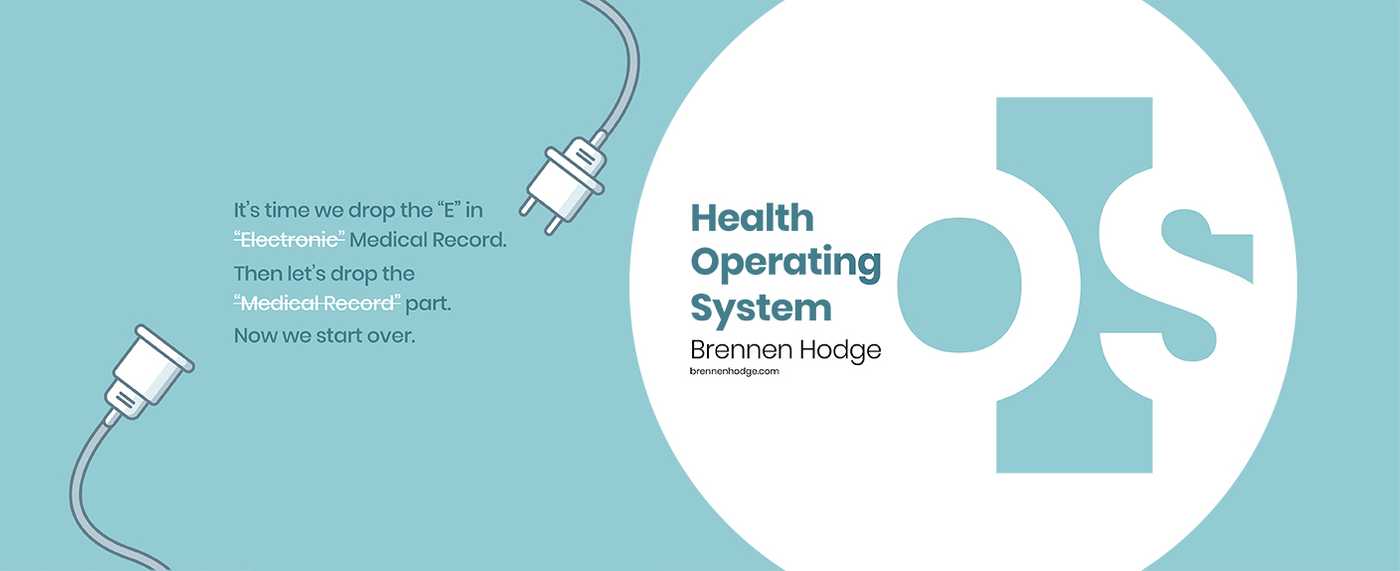Brennen Hodge is CEO at Citizen Health, an entrepreneur on a mission to make the world a better place. brennenhodge.com
It's time we drop the "E" in "Electronic" Medical Record.
Then let's drop the "Medical Record" part.
Now we start over.
Let’s rethink what we’re trying to accomplish with software in healthcare.
Our objectives should be:
- Keeping people healthy by predicting & preventing illness
- Providing the best diagnosis & treatment possible
- Eliminating medical errors
- Enabling rational, fair, & affordable prices
All of this with minimal costs & friction to everyone involved.
However, no software, payment system, or business model is designed for that experience.
As Peter Thiel says, “It's time to go from Zero to One.”
It's time to build something new -- an epic moonshot. Let's build a Health Operating System.
What is a HealthOS?
Fundamentally, an operating system is a set of instructions that optimizes the components of a larger system. The instructions can be written in bits (computer code), atoms (genetic code), or beliefs (money & law). The HealthOS applies them all to coordinate:
- Health Needs
- Health Solutions
- Data
- Money
While there are many good open source EHRs in existence, the HealthOS starts with a fresh canvas by removing constraints and considering what will be possible with future technology.
Pieces of this HealthOS are already being build by talented people all around the world, but without a unified goal. We must come together and leverage the collective power of our open source communities to build software that works for humanity. The following are some projects to tap.
To learn, we've got to feed this OS plenty of health data by connecting wearables, sensors, devices, labs, and hospitals using Mediflux. Using the Standard Health Record, we apply machine learning to the beautiful data we have streaming in by the zettabytes.
Our data is cleaned, organized, and combined with the Open Humans database to be collaboratively used for citizen science research. Even more, you collect dividends when research companies use your data in trials.
Data should tell a unique story. We should visualize out health in one view using hGraph, along with continuous monitoring to be alerted if negative patterns emerge.
When we do need to see a doctor, we utilize WebRTC to connect directly via video or messaging. When physical visits are necessary, interactions will be personal and efficient, leveraging voice, touch, and gestures --no more mouse or keyboard. With dynamically shared information, both you and your care team collaborate intelligently on healthcare issues to minimize medical errors and optimize treatment plans.
Now that we have patients and providers using the OS, we connect everyone on a decentralized marketplace such as Medoplex. Transactions are executed using trusted smart contracts on a federated blockchain network. Each device is a node storing encrypted health records and staking reputation using the Proof of Health protocol. Fraud is eliminated, prices are rational, and payments are instant.
For this to work at scale, all parties need to have skin in the game with aligned incentives. That's why the HealthOS is a digital cooperative owned by everyone who uses it. Healthcare professionals propose & vote on exactly what their software should do, and then work with developers to build it. All decisions are transparent and governed by meritocracy.
Once the HealthOS is launched, network effects kick in to jumpstart the largest open source community in healthcare. With every new user interaction, the HealthOS improves to serve the greater good of humanity.
As the modern successor to the Hippocratic Oath, the Declaration of Geneva states:
“I will share my medical knowledge for the benefit of the patient and the advancement of healthcare.”
As software and medicine become more inseparable, we must view code as medical knowledge. Therefore, we have the moral & ethical obligations to open source our innovations with the world.
It's time we take collective action and join forces to build the infrastructure our future healthcare systems need. By leveraging open source software and communities, we can solve problems in healthcare faster and cheaper. We must align vectors to achieve maximum impact and progress.
